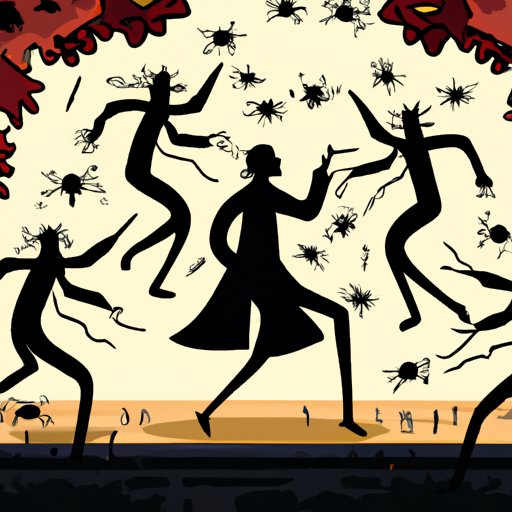Introduction
The Dancing Plague of 1518 was a bizarre phenomenon that occurred in Strasbourg, France in the summer of 1518. It began with a single woman and eventually spread to dozens of people who were uncontrollably dancing in the streets for days or even weeks at a time. The cause of this strange event has mesmerized historians and scientists for centuries, and its legacy continues to be studied today.
The purpose of this article is to explore the origins and implications of the Dancing Plague of 1518. We will look at the history of the event, examine possible causes, and investigate the psychological and social implications of the phenomenon. Ultimately, we will try to uncover the truth behind this mysterious and often misunderstood event.

A History of the Dancing Plague: Uncovering the Origins of a Bizarre Phenomenon
The Dancing Plague of 1518 began on the morning of July 14th in Strasbourg, France. A woman known as Frau Troffea stepped out into the street and began to dance uncontrollably. Within a few days, 34 more people had joined her in what seemed to be an uncontrollable state of dancing mania.
The dancing continued for several days, with reports of some of the dancers collapsing from exhaustion. Eventually, the townspeople called in a physician, Dr. Johann Stumpf, who declared that the dancers must be possessed by demons and recommended that they be exorcised. However, the dancing continued until the end of August, when it suddenly stopped as mysteriously as it had begun.
Theories surrounding the cause of the Dancing Plague of 1518 have varied over the years. Some experts have suggested that it was a form of mass hysteria, while others have argued that it was caused by a contagious disease or a toxic substance. Despite the fact that the cause remains unknown, the event itself has become a source of fascination for many.
Exploring the Causes of the 1518 Dancing Plague in Strasbourg, France
In order to understand the cause of the 1518 Dancing Plague, it is important to consider the various theories that have been proposed. First, let us look at the psychological causes.
Psychological Causes
One theory suggests that the Dancing Plague was a result of mass hysteria. This theory holds that the participants were suffering from a collective delusion caused by fear and anxiety. It is possible that the dancers were experiencing a form of psychogenic illness, which is a mental disorder characterized by physical symptoms that cannot be explained medically.
Social Causes
Another theory suggests that the Dancing Plague was caused by social factors. It is possible that the dancers were responding to a situation in which they felt powerless or overwhelmed. This could have been due to economic hardship, religious persecution, or any other number of factors. It is also possible that the dancers were attempting to express their frustration or dissatisfaction with their current situation.
Medical Causes
Finally, some experts have suggested that the Dancing Plague was caused by a medical condition. It is possible that the dancers were suffering from ergotism, which is a condition caused by eating contaminated rye bread. Ergotism can cause hallucinations, convulsions, and other symptoms that could explain the uncontrollable dancing. Alternatively, it is possible that the dancers were suffering from encephalitis lethargica, a rare neurological disorder that can cause paralysis and other symptoms.
Re-Examining the Dancing Plague of 1518: Was it Really a Mass Hysteria?
Many experts believe that the Dancing Plague of 1518 was a form of mass hysteria. However, there are some who argue that the phenomenon was something else entirely. In order to determine the truth, it is important to examine the evidence from multiple perspectives.
Different Perspectives on the Phenomenon
Some experts believe that the Dancing Plague was a form of mass hysteria, while others suggest that it was caused by a contagious disease or a toxic substance. It is also possible that the phenomenon was a combination of these factors. In order to understand the true cause, it is important to consider all of the possible explanations.
Examining the Evidence
The available evidence does not provide a definitive answer as to what caused the Dancing Plague of 1518. However, it does shed light on some of the possible causes. For example, the fact that the dancers collapsed from exhaustion suggests that they were suffering from a physical ailment. Additionally, the fact that the dancing stopped suddenly and without explanation suggests that the cause may have been psychological in nature.
What We Can Learn From the Dancing Plague of 1518
Although the cause of the Dancing Plague of 1518 remains a mystery, there are still some valuable lessons to be learned from the event. One of the most important is the role of social interaction in mental health. The fact that the phenomenon spread so quickly and affected so many people suggests that the dancers were responding to a shared emotional experience.
The Dancing Plague of 1518 also serves as a reminder of the importance of mental health awareness. The fact that the dancers were unable to control their behavior suggests that they were suffering from an undiagnosed mental illness. This highlights the need for greater understanding and awareness of mental health issues.

Investigating the Psychological and Social Implications of the Dancing Plague
The Dancing Plague of 1518 had a profound effect on the community of Strasbourg. Many of the dancers experienced physical exhaustion and some even died as a result of their condition. Additionally, the event caused widespread fear and confusion among the townspeople.
The event also had a significant impact on mental health. The dancers were unable to control their behavior, which suggests that they were suffering from a psychological disorder. It is possible that the phenomenon served as a warning sign of underlying mental health issues in the community.
The Medical Mystery of the Dancing Plague: What Was It Really?
The cause of the 1518 Dancing Plague remains a mystery. Although there are a number of theories, none of them have been proven conclusively. In order to gain a better understanding of the phenomenon, it is important to examine the available evidence.
Examining the Medical Evidence
Although the cause of the Dancing Plague remains unknown, there is some evidence that suggests that it may have been caused by a medical condition. For example, the fact that some of the dancers collapsed from exhaustion suggests that they may have been suffering from a physical ailment. Additionally, the sudden and unexplained cessation of the dancing suggests that the cause may have been a medical issue.
Possible Explanations
It is possible that the Dancing Plague of 1518 was caused by ergotism, a condition caused by eating contaminated rye bread. Alternatively, it is possible that the dancers were suffering from encephalitis lethargica, a rare neurological disorder that can cause paralysis and other symptoms. Additionally, it is possible that the phenomenon was caused by a combination of psychological, social, and medical factors.
Conclusion
The Dancing Plague of 1518 was a mysterious and often misunderstood event. Although the cause remains unknown, the event provides insight into the role of social interaction in mental health and the importance of mental health awareness. Additionally, the available evidence suggests that the phenomenon may have been caused by a combination of psychological, social, and medical factors.
Ultimately, the Dancing Plague of 1518 serves as a reminder of the power of collective emotion and the importance of understanding and addressing mental health issues. By studying this event and its implications, we can gain a greater understanding of the human mind and the influence of our emotions on our behavior.
(Note: Is this article not meeting your expectations? Do you have knowledge or insights to share? Unlock new opportunities and expand your reach by joining our authors team. Click Registration to join us and share your expertise with our readers.)
